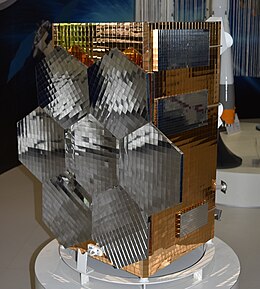You can help expand this article with text translated from the corresponding article in French. (April 2016) Click [show] for important translation instructions.
|topic= will aid in categorization.Content in this edit is translated from the existing French Wikipedia article at [[:fr:Mikhaïl Lomonossov (satellite)]]; see its history for attribution.{{Translated|fr|Mikhaïl Lomonossov (satellite)}} to the talk page. |
Mikhailo Lomonosov (MVL-300, or Mikhailo, or more commonly Lomonosov; MVL stands for Mikhail Vasilyevich Lomonosov[4]) is an astronomical satellite operated by Moscow State University (MSU) named after Mikhail Lomonosov.[5]

A model of the Mikhailo Lomonosov
| |||||||||||||||||||
| Mission type | Astronomy | ||||||||||||||||||
|---|---|---|---|---|---|---|---|---|---|---|---|---|---|---|---|---|---|---|---|
| Operator | MSU | ||||||||||||||||||
| COSPAR ID | 2016-026A | ||||||||||||||||||
| SATCAT no. | 41464 | ||||||||||||||||||
| Website | lomonosov.sinp.msu.ru | ||||||||||||||||||
| Mission duration | Planned: 3 years [1] | ||||||||||||||||||
| Spacecraft properties | |||||||||||||||||||
| Manufacturer | VNIIEM | ||||||||||||||||||
| Launch mass | 620 kg (1,370 lb)[1] | ||||||||||||||||||
| Payload mass | 170 kg (370 lb)[1] | ||||||||||||||||||
| Power | ~300 W[1] | ||||||||||||||||||
| Start of mission | |||||||||||||||||||
| Launch date | 28 April 2016, 02:01 UTC | ||||||||||||||||||
| Rocket | Soyuz-2.1a/Volga | ||||||||||||||||||
| Launch site | Vostochny Site 1S | ||||||||||||||||||
| Contractor | Roscosmos | ||||||||||||||||||
| End of mission | |||||||||||||||||||
| Deactivated | 14 January 2019 | ||||||||||||||||||
| Decay date | 16 December 2023 | ||||||||||||||||||
| Orbital parameters | |||||||||||||||||||
| Reference system | Geocentric | ||||||||||||||||||
| Regime | Sun-synchronous | ||||||||||||||||||
| Semi-major axis | 6,856 kilometers (4,260 mi)[2] | ||||||||||||||||||
| Perigee altitude | 478.2 km (297.1 mi)[2] | ||||||||||||||||||
| Apogee altitude | 492.9 km (306.3 mi)[2] | ||||||||||||||||||
| Inclination | 97.3 degrees[2] | ||||||||||||||||||
| Period | 94.2 minutes[2] | ||||||||||||||||||
| |||||||||||||||||||
The objective of the mission is the observation of gamma-ray bursts, high-energy cosmic rays and transient phenomena in the Earth's upper atmosphere.[5]
The mission launch was initially planned for 2011 when 300 years since the birthday of Mikhail Lomonosov was celebrated.[6] After several postponements the mission was finally launched on 28 April 2016 from Vostochny Cosmodrome by the Soyuz 2.1a launch vehicle.[7]
The spacecraft is equipped with seven scientific instruments:[4][1]
The TUS-telescope aboard Lomonosov stopped data collection in late 2017.[8]
On June 30, 2018, it was published that the Lomonosov-satellite had suffered a malfunction in its data transmission system. Attempts to fix the problem were underway, but fixing the problem had so far been unsuccessful.[9]
As of 14 January 2019, the problems had not been solved and all the scientific equipment of the satellite were powered off. The recovery attempts continued (some systems of the satellite were responsive, the problem was with scientific payload systems). Before succumbing to these difficulties, the satellite had worked for one and a half years for its intended purpose. With the failure of the Lomonosov satellite and the Spektr-R end of mission on 30 May 2019, the Russian space program lost both of its scientific satellites until the launch of Spektr-RG in July 2019.
The satellite decayed from orbit on 16 December 2023.[10]